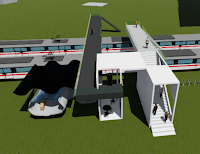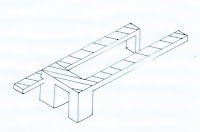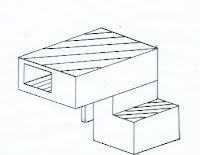Experiment 2
Concepts
Adolf
Loos
·
Ornament
results in the undue obsolescence of everyday objects.
·
Ornament
is a sign of degeneracy.
·
Loos
alludes to the timeless qualities of architecture devoid of
ornamentation.
·
Focus on
uses of space.
·
Loos
equates ornaments with “savagery”.
·
Progress
of culture is associated with the deletion of ornament from everyday
objects.
·
Eliminating
wastefulness.
·
The urge
to ornament one’s self is the baby talk of painting.
·
A blank
canvas can be more.
·
Buildings
often composed of pure forms and justified by their economic
practicality and utilitarian qualities.
·
To not
mask the true nature and beauty of materials by useless and indecent
ornament.
·
The true
vocabulary of architecture lies into the materials themselves. The building
should remain dumb on the outside and contrast austere facades with lavish
interiors.
Rural
Studio
·
“Architecture
more than any other art form, is a social art and must rest on the social and
cultural base of its time and place” – Samuel Mockbee.
·
Establishing
the ethos of recycling, reusing and remaking.
·
The studio
questions what should be built rather than what can be built.
·
Everyone
both rich and poor deserves good design.
·
Rural
studio encourages the use of wood as a renewable and readily available material
throughout the studio.
·
The
initial sketch is always an emotion not a concept.
Axonometrics
Focus on uses of space
Eliminating wastefulness
To not mask the true nature and beauty of materials
by useless and indecent ornament
The initial sketch is always an emotion not a concept

Everyone both rich
and poor deserves good design
“Architecture more than any other art form, is a
social art and must rest on the social and cultural base of its time and place”
Combined
Axonometrics
Textures
Model
Technology: This
Light rail stop design centres around the idea of technology and how technology
can be used to make using public transport quicker and easier. The first image shows the undercover place where people would sit when waiting for their
light rail stop. When a tram begins to arrive this whole area will light up in
a red colour. Warning people to begin walking toward the stop. The next image shows interactive screen that have the app “TripView” on them this means
that people can see how long the next tram will be coming and the different
stops it goes to. This will be continually updated and therefore the arrival
times will always be accurate.
Concepts: The first concept relates to everyone having access to good design. I have implemented this through the use of technology as it allows everyone no matter rich or poor to have access to these luxuries such as an up to date timetable of the arrival time of the trams. I believe rich and poor does not just relate to how much money you have but also the opportunities you have in life. Which is why the light up idea on arrival can benefit people that are deaf and who would otherwise not be able to hear when an announcement would come over the speaker or hear the tram coming. However it also benefits everyone as they could be listening to music or not paying attention. Where as this light up system would immediately draw peoples attention.
The other concept relates to use of space and I have implemented this concept throughout my whole design by ensuring that all spaces of the design have more than one function as well as making sure that all spaces have a particular purpose and are not just wasted space. For example putting a seating area under the stairs as well as the interactive screens underneath the stairs.
Concepts: The first concept relates to everyone having access to good design. I have implemented this through the use of technology as it allows everyone no matter rich or poor to have access to these luxuries such as an up to date timetable of the arrival time of the trams. I believe rich and poor does not just relate to how much money you have but also the opportunities you have in life. Which is why the light up idea on arrival can benefit people that are deaf and who would otherwise not be able to hear when an announcement would come over the speaker or hear the tram coming. However it also benefits everyone as they could be listening to music or not paying attention. Where as this light up system would immediately draw peoples attention.
The other concept relates to use of space and I have implemented this concept throughout my whole design by ensuring that all spaces of the design have more than one function as well as making sure that all spaces have a particular purpose and are not just wasted space. For example putting a seating area under the stairs as well as the interactive screens underneath the stairs.
https://www.dropbox.com/s/inmsp3d2xmw9obo/Meagher%20Holly%20UNSW%20stop.ls7?dl=0






































Comments
Post a Comment